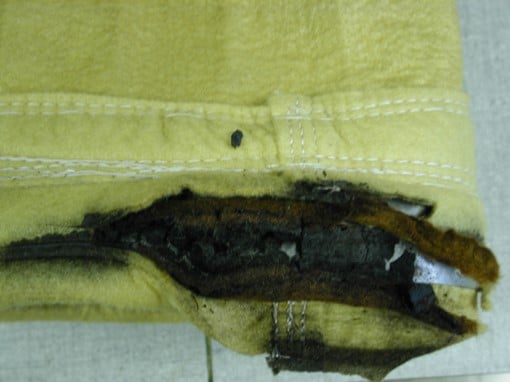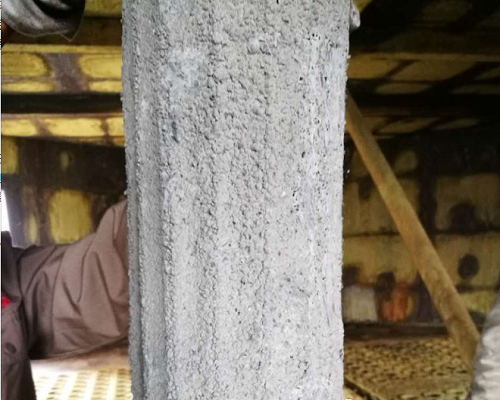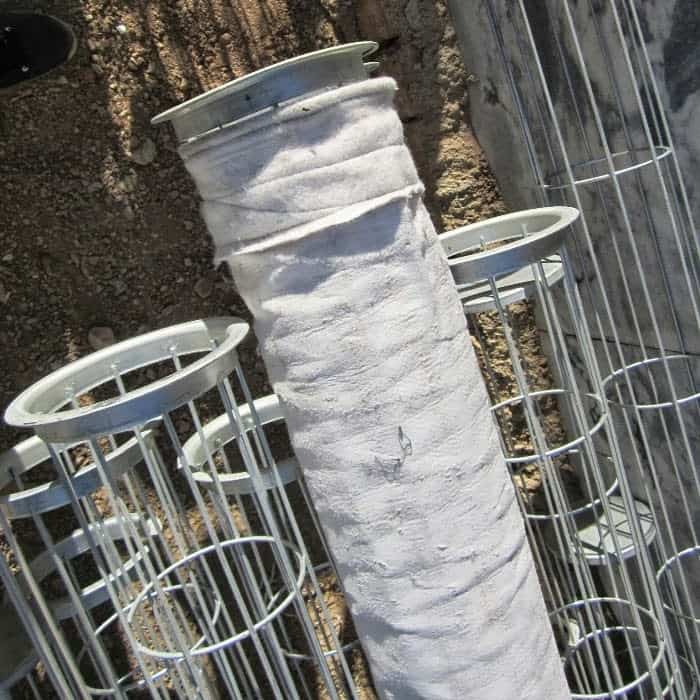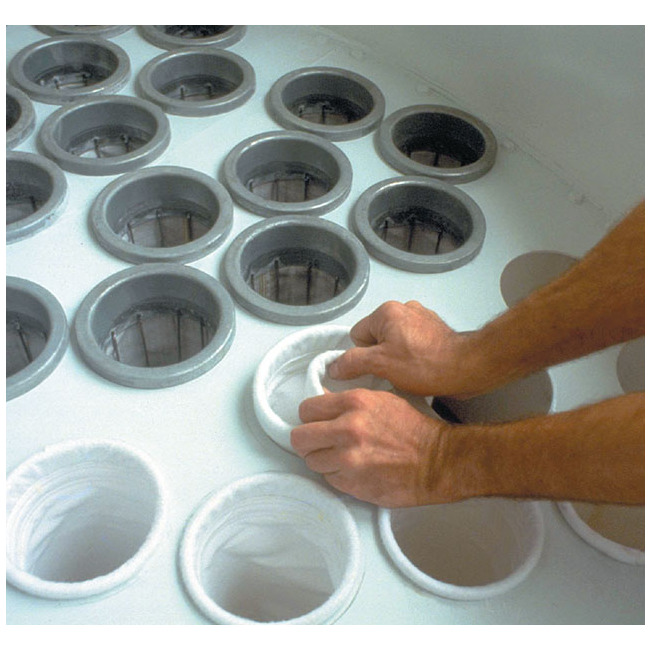Dust collector filter bags are a vital component of any industrial dust collection system. They capture the fine airborne particles generated during the production process, ensuring that these hazardous and potentially explosive materials are contained for safe disposal or reuse.
Unfortunately, over time, dust collector filter bags can become damaged causing a decrease in their efficiency and an increase in air pollution. The five most common causes of damage to dust collector filter bags are:
1. Abnormal Operating Conditions:

Dust collector filter bags can become damaged if the system is operated at high temperatures, pressures or velocities that exceed the design limits of the bag material. Additionally, exposure to corrosive chemicals and high humidity can cause premature wear on the bag material.
The temperature of a baghouse operation must be monitored as high temperatures can cause deterioration of the filter bags. A common mistake made with filter bags is incorrect cleaning cycles – like most fabrics, too much cleaning will result in greater wear and tear over time.
If you over-wash your jeans, you’ll end up having to buy a new pair sooner than necessary. It is the same case with dust collector filter bags – proper cleaning cycles must be determined and adhered to.
A form of build-up that occurs sometimes on filter bags is moisture related. If oils or moisture get into the baghouse they will cause dust to build-up on the filters. This dust created by moisture cannot be removed from the bags, meaning the only solution is to replace them.
2. Incorrect Size or Type of Bag
A problem often created with baghouse design is that it is too small for its intended purpose. If a baghouse doesn’t have enough space, this results in an excessive amount of air passing through the filters. If the dust collector filter bags are not properly sized for the system, they may be subject to over-pressurization and potential failure.
Additionally, if the wrong type of bag is used it can cause higher levels of wear and tear on the material due to improper fit or incompatibility with the dust collection media. It would be as if a handheld vacuum were attempting to clean up a huge mound of dust–the filters would get clogged and eventually fail. This is one of the most common causes of damage to dust collector filter bags.
If the dirt evacuation system isn’t properly sized for the project, air will flow back into the hopper instead of out. This results in dust flowing back up and causing premature wear on bags. The flow of air back to the hopper can also cause the bags to tear or rupture due to excessive back pressure.
If a dust collector has a poor inlet design, the airflow may cause buildup in one area of the baghouse. The build-up would add large amounts of dust to cling to the filter bags. As a result, the bags used would need to be replaced more frequently. As a result, the filter bags can become prematurely damaged.
3. Clogged Bags:

A large contributor to damage to the dust collection system can be the filter bag. As dust accumulates in the filter bags, they can become clogged and compacted which causes increased pressure on the bag material leading to premature failure or breach of the fabric.
Clogged dust collector bags pose a serious threat to any work environment since they can affect air flow and pressure levels. When there is excessive pressure or constant airflow, it can cause the bag to rip or tear, leading to an unfortunate mess.
In particular, clogged bags decrease the amount of air that flows through them, reducing the effectiveness of the dust collector system – this means that more pollutants are likely to be released into an already busy workplace.
Not only does this create a bigger hassle for cleaning and maintenance, but often dust and debris will escape from the system when it’s broken, potentially causing greater health and safety issues. On top of this, an increase in pressure can cause these pollutants to spread even further and contaminate areas that were not previously at risk.
As a result, it is essential to ensure that dust collector bags are kept clear by regularly maintaining and cleaning them. Keeping up with regularly scheduled routine inspections of the filter bags greatly alleviates the threat of these risks presenting themselves in your setting. Doing so will help create a safe workplace for all employees with the benefit of improved air quality.
4. Mechanical Damage:

Mechanical damage is one of the most common causes of filter bag failure in dust collectors. This type of damage can be caused by a number of different factors, including abrasion, welding spatter, and airborne metal particles. Abrasion happens when particulate matter rubs against the filter bag during operation, wearing down its fibers over time; this is usually seen in applications with very fine and abrasive particles.
Abrasion from abutting surfaces, such as ducting, hoppers, and other equipment parts can cause holes or tears in the filter bag fabric leading to a decrease in air flow efficiency. Additionally, foreign objects entering the system may also pierce or tear the fabric causing long-term damage if not addressed immediately.
Welding spatter can become stuck to the surface of filter bags, leading to tear or gouge points where mechanical forces can easily break it apart. Also, metallic particles that are suspended in the air can also cause scrapes or abrasions if they adhere to the bag’s surface. All three types of mechanical damage are detrimental to proper filtration and should be guarded against through routine inspection and maintenance.
It’s important to correctly identify and address any mechanical damage that may occur on the filter bags before it damages other parts of the system. Fortunately, there are easy-to-spot signs that indicate any mechanical damage on your dust collector filter bags.
Loose fabric can be seen where a thread has broken or worn away, or there may also be evidence of abrasion caused by grit or material forcibly grinding against the surface of the bag. In addition, contact with other hot surfaces such as exhausts or welds can cause observed scorching or discoloration on the fabric itself. By paying attention to these tell-tale signs and attending to any mechanical damage quickly and efficiently, you will be able to maximize performance while keeping maintenance costs down.
5. Chemical Attack:

Filter bags can be slowly degraded when exposed to certain chemicals. Chemical attacks can occur from the air stream or direct contact with caustic materials. These filters do a crucial job, and to keep them functioning well requires understanding the types of chemicals that may be circulating within the dust-collecting environment.
Dust collector filter bags can come into contact with acidic compounds, base compounds, salts, grease, fats, oils, and other organic materials. If a material becomes too acidic or basic it can cause damage to the filter bags if not adjusted quickly enough or addressed properly.
The chemicals used in manufacturing processes can have detrimental effects on filter bags. Depending on the level of exposure, these chemicals can accumulate over time and cause pores to close up and reduce filtration capacity.
In extreme cases, the filter bag can completely break down resulting in costly production delays. The key to managing these risks is to ensure that maintenance personnel regularly inspects bags for signs of chemical damage and replaces them as needed. This will ensure that the facility remains up to standards and avoids potential problems down the line.
To prevent chemical degradation, special filter bags should be used that are designed for corrosive environments. Additionally, it is important to avoid using water to clean dust collector filter bags as this may result in the release of harmful chemicals into the air stream. However, with proper maintenance, dust collector filter bags can lead to a healthier working environment and a safer workplace.
Conclusion

In order to maintain effective baghouse performance and the life of your filter bags, it is important to conduct regular inspections and follow a recommended maintenance plan. This includes regularly checking for mechanical damage, inspecting filters for clogging or build-up, and monitoring temperature levels in the system.
Additionally, using the right type of filter bag based on the particular application and dust type is essential for preserving filter life. It is important to address any issues immediately as they can quickly cause damage and reduce bag life. Proper maintenance practices can help to ensure the longevity of dust collector filter bags and keep your system running efficiently.
Sofilt offers a wide range of dust collector filter bags designed to meet the needs of any industry. Our team is dedicated to providing customers with the best filter solutions for any dust collecting environment.
Contact us today to learn more about our dust collector filter bags and how we can help you maintain your system. With our highly skilled and knowledgeable team, we can provide the perfect filter solution for your specific application.




